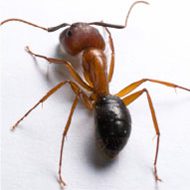Carpenter Ants
Range in color from brown to red, black, or a combination; segmented, oval; 1/4 to 3/8-inch in length; large mandibles

May range from red to black in color.
Build nests in deteriorating, moist wood; often the colony will extend its nest into adjacent, sound wood.
Are commonly found in porch pillars and roofs, window sills, telephone poles, live and dead tress, rotting logs and stumps and wood in contact with soil.
Do not actually eat the wood removed during nest-building activities; rather, deposit it outside entrances to the colony in small piles.
Diet: Carpenter ants primarily eat the same food as humans, such as meats, cheese, and sweets, but also insects. Despite their name, carpenter ants do not eat wood.
Habitat: Decaying, moist, or hollow wood is preferred. Carpenter ants build their nests outdoors in various wood sources, including tree stumps, firewood, or landscaping. They need a constant water source to survive, so usually enter homes through wet, damaged wood.
Threats: Carpenter ants rarely come in contact with humans and do not pose a threat, however they can damage the structure of your property due to their nest building.
Prevention: Treating the parent colony is necessary for carpenter ant control as well as any surrounding nests. For the best defense, store firewood away from your home and keep your landscape maintained by removing stumps and trimming dead limbs on trees. Ensuring there are no leaks in your roof and plumbing is also beneficial.
